Apricot jam is the perfect way to preserve the fresh flavor of apricots all year long! Imagine this: It’s Sunday morning, the smell of freshly toasted French bread is wafting through the air, a dollop of melted butter is spread below a slather of this sweet homemade apricot jam. Are you drooling yet?
Homemade jam is simply put, better! There’s something so satisfying about making homemade jams and jellies, plus it allows you to control the ingredients, giving you peace of mind.
You’re going to love the bright flavor of this apricot jam that requires only three simple ingredients: apricots, sugar, and lemon juice! No pectin needed! This versatile preserve from Ball® home canning products can be enjoyed as a breakfast condiment or served alongside a savory dish. Scroll down for the full printable recipe, with tips and tricks for making the perfect jam!
This post is sponsored by the makers of Ball® home canning products.*
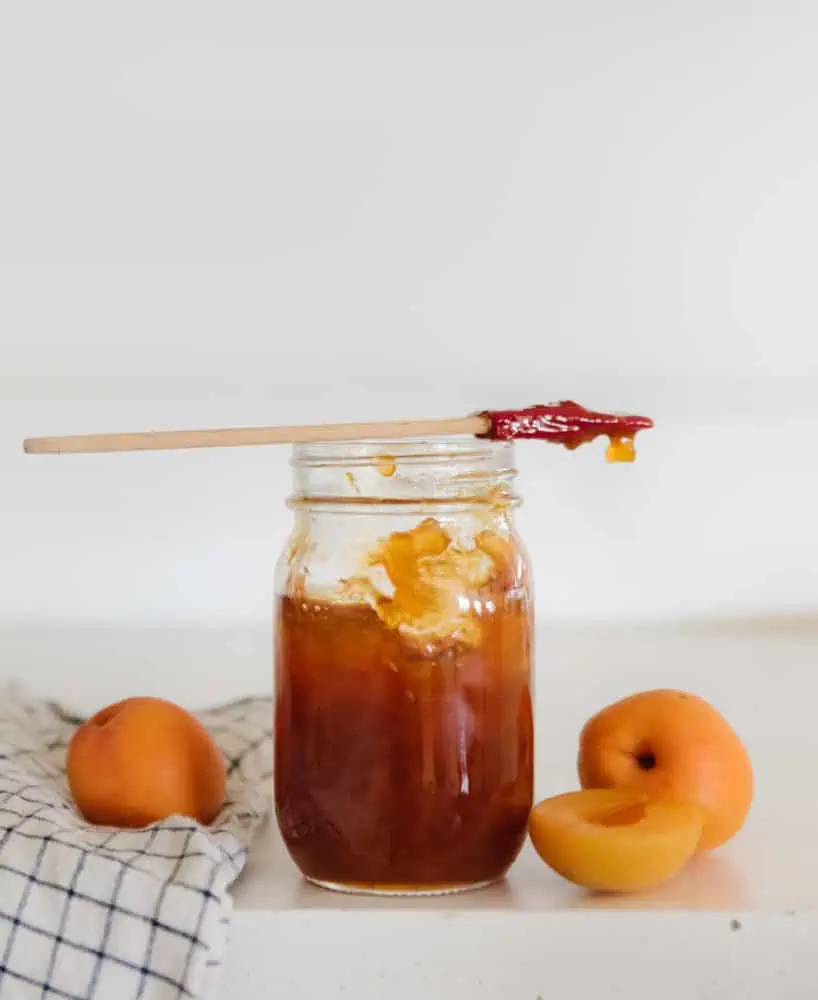
Table of contents
Why We Love This Recipe
This is a classic recipe found in the pages of the Ball® Blue Book® Guide to Preserving 37th-Edition. One of my favorite cookbooks for home canning, as each recipe is thoroughly tested and very tasty!
Apricots are a delicious fruit with a bright flavor, yet like other stone fruits, only come into season once per year. Preserving their flavor in beautiful Ball® home canning products mason jars allows you to enjoy the flavor all year long!
Apricot jam is incredibly easy to make, and doesn’t require the use of pectin! This is a great recipe for a beginner canner. With just three simple ingredients, it’s beyond easy to bring together!
This recipe is delicious and we love it slathered across a slice of crusty French bread! It is a refrigerator staple that can be used for more than just atop toast. Try mixing into marinades, salad dressings, or even cocktails! This is a very versatile jam for a variety of uses!
Read below to learn how to make the best homemade apricot jam!
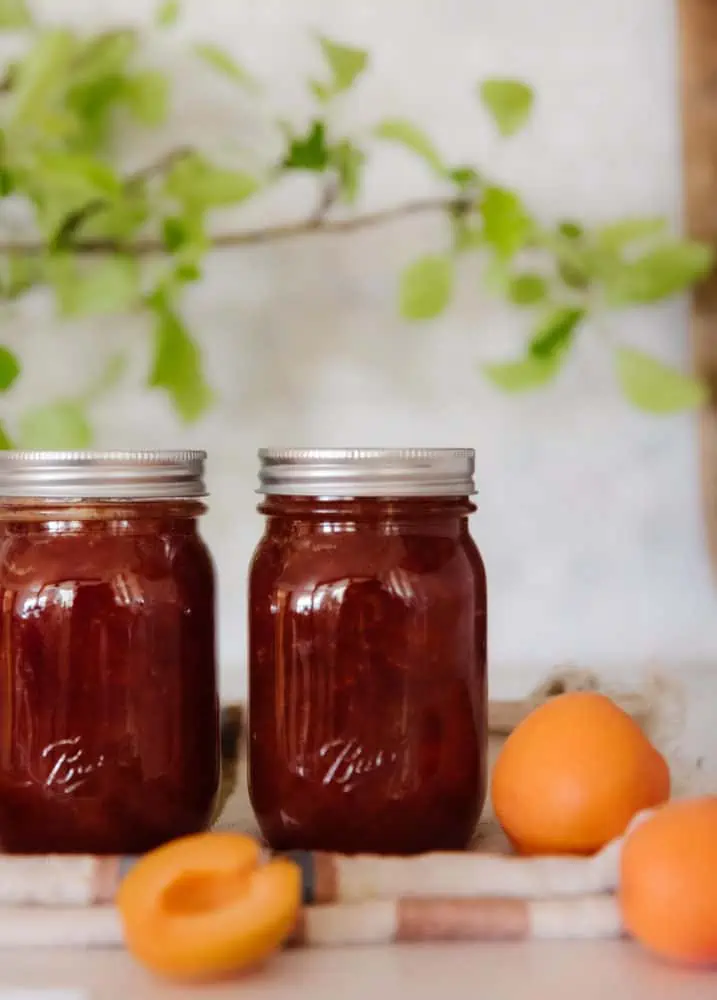
Apricot Jam Ingredients
- Apricots: Always reach for the freshest fruit when making jams or jellies. Fruit at its peak ripeness will make for the best preserves, avoid mushy or overripe produce.
- Lemon Juice: Lemon juice aids in achieving the correct pH when making preserves, additionally it balances out the flavor of the sugar.
- Sugar: Sugar acts as a preservative and helps the jam reach the proper gelling point. It is important not to reduce the amount of sugar and follow the instructions precisely to ensure food safety.
Don’t forget to select quality mason jars when home canning, I always turn to Ball® home canning products because I know that I can trust the durability and safety of the jars! Stock up for the entire canning season, shop them here!
Step by Step Instructions For Apricot Jam
Be sure to scroll all the way down for the full printable recipe with helpful tips and tricks!
- Start by preparing a boiling water canner. Heat Ball® jars in simmering water until ready to use, do not boil. Wash lids in warm, soapy water and set aside with bands.
- Prep the apricots with a quick wash under cool water. To remove the skins, blanche in boiling water for about 60 seconds, immediately transfer to cold water, then cut off the peel.
- Cut the apricots in half to remove the pits. Coarsely chop and crush using a potato masher. Measure 2 quarts of crushed fruit.
- Combine all ingredients in a large pot such as a dutch oven or stock pot. Bring mixture slowly to a boil and stir until sugar dissolves. Then bring the mixture to a full rolling boil and cook until it reaches 220°F, be sure to stir to prevent sticking. It should take about 40 minutes!
- Ladle hot jam into a hot jar, leaving ¼-inch headspace. Remove air bubbles, Clean jar rim. Center lid on jar and adjust band to fingertip-tight. Place jar on the rack elevated over simmering water (180°F) in boiling-water canner. Repeat until all jars are filled.
- Process the Jam: Lower the rack into simmering water. Water must cover jars by 1 inch. Adjust heat to medium-high, cover canner and bring water to a rolling boil. Process pint jars 15 minutes (adjusting for altitude). Turn off heat and remove cover. Let jars cool 5 minutes. Remove the Ball® jars from canner; do not retighten bands if loose. Cool 12 hours. Check seals. Label and store jars.
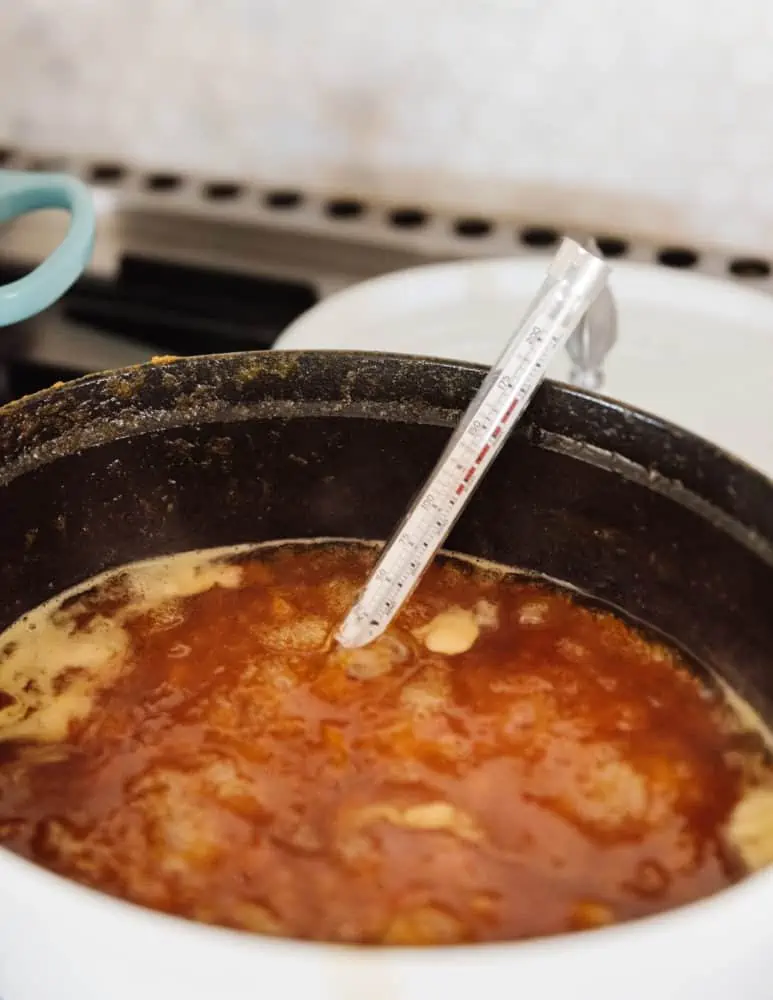
Tips For Success & FAQs
- Select fruit at its peak freshness for the very best jams and jellies! Mushy or overripe fruit should be skipped over. Remember you’re preserving the fruit as it is – so select the best of the best to be enjoyed throughout the year!
- This recipe makes 3-5 pint jars of jam, make one for yourself and a few to gift to family and friends!
- To easily crush the fruit, use a potato masher!
An instant read candy thermometer is the easiest way to know when jam is ready! The gelling point of jams and jellies is 220°F. If an instant read thermometer isn’t available, place a small plate in the freezer for 10-15 minutes, remove and spoon a dollop of hot jam onto the cold plate. Once the jam is cool to the touch, run your finger through the center of the dollop, the jam should clearly separate into two and not puddle back into a single dollop.
It is very important to follow home canning recipes exactly to ensure food safety. Sugar should not be reduced in this recipe.
This jam recipe is shelf stable, meaning it can be stored in a cool dry place out of direct sunlight for up to one year! Once opened, keep refrigerated and enjoy within one month. (source)
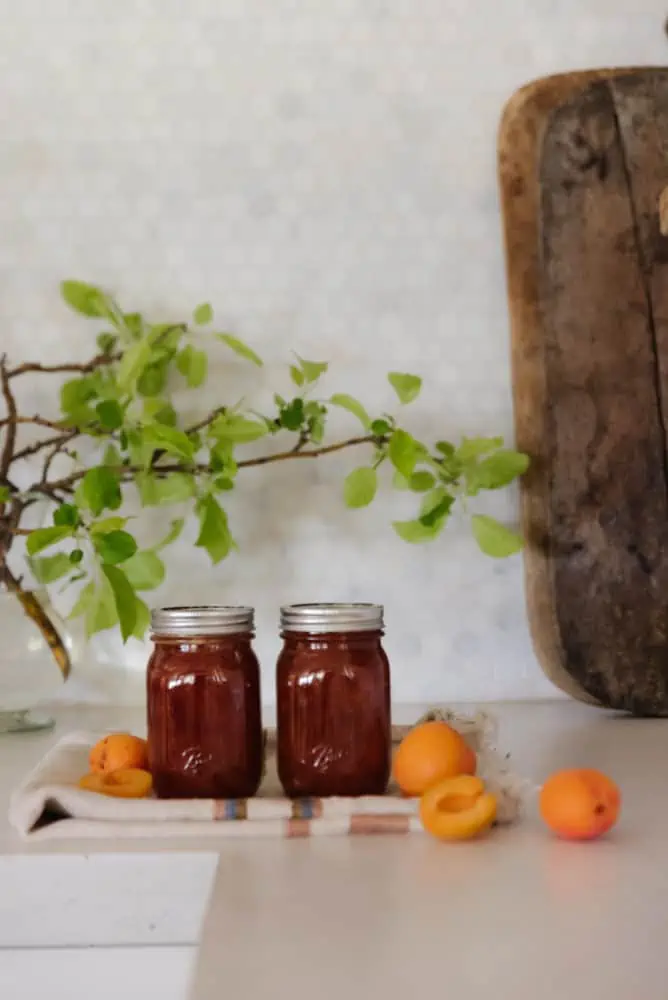
More Recipes for you to Try
If you love home canning, be sure to check out all of our preserving recipes made with Ball® mason jars! Fig jam from Ball® home canning products is a reader favorite as is this quick and easy orange marmalade recipe!
If you’re in the mood for breakfast this apricot jam would be delicious served with a homemade dutch baby pancake or authentic French crepes!
The Recipe
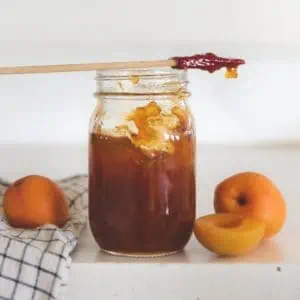
The Best Homemade Apricot Jam
Equipment
Ingredients
- 2 quarts crushed peeled, pitted apricots (about 4 pounds or 30 medium sized apricots)
- 1/4 cup lemon juice about 1 large
- 6 cups granulated sugar
Instructions
- Prepare boiling water canner, heat jars in simmering water until ready to use, do not boil. Wash lids in warm, soapy water and set aside with bands.
- Wash apricots under cold running water; drain. To peel apricots, blanch in boiling water 30 to 60 seconds. Immediately transfer to cold water. Cut off peel.
- Cut apricots in half lengthwise; remove pits and fibrous flesh. Coarsely chop apricots, then crush using a potato masher. Measure 2 quarts crushed apricots.
- Combine crushed apricots, lemon juice, and sugar in a large saucepan. Over medium heat, bring mixture slowly to a boil, stirring until sugar dissolves.
- Increase heat to medium-high and cook rapidly to gelling point (220°F), stirring to prevent sticking, about 40 minutes. Remove from heat. Skim off foam if necessary.
- Ladle hot jam into a hot jar, leaving ¼-inch headspace. Remove air bubbles, Clean jar rim. Center lid on jar and adjust band to fingertip-tight. Place jar on the rack elevated over simmering water (180°F) in boiling-water canner. Repeat until all jars are filled.
- Process the Jam: Lower the rack into simmering water. Water must cover jars by 1 inch. Adjust heat to medium-high, cover canner and bring water to a rolling boil. Process pint jars 15 minutes (adjusting for altitude). Turn off heat and remove cover. Let jars cool 5 minutes. Remove jars from canner; do not retighten bands if loose. Cool 12 hours. Check seals. Label and store jars.
Notes
*This is a sponsored post that is part of an ongoing partnership with the Fresh Preserving Division of Newell Brands. They have provided jars, equipment and monetary compensation. All thoughts and opinions expressed remain my own.
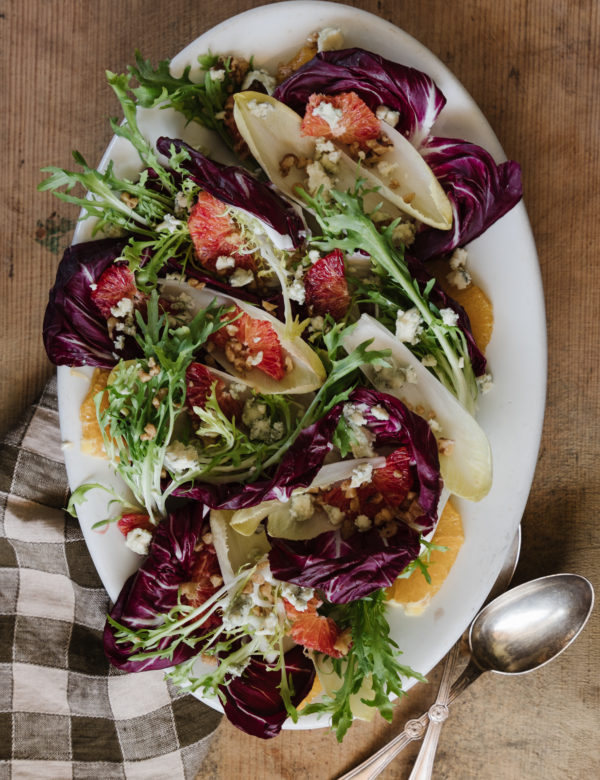

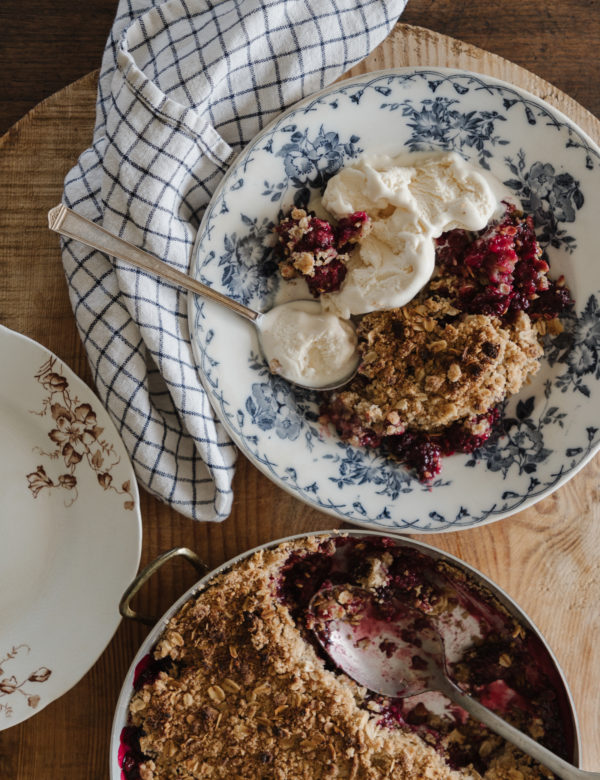

Of all the fruits that can be made into drinking water, the taste of apricot juice is always very special for those who drink it next time.
Some of my friends also say that people with quiet souls often enjoy nostalgia.
This article does a great job of providing a comprehensive overview of the advantages and disadvantages of ethical dilemma topics. It explains the potential benefits and pitfalls of different topics, and provides several examples to illustrate these concepts. I appreciate the concrete examples provided, as they are extremely helpful in understanding the nuances of choosing the right topic.
Amazing! Your ideas were amazing and delightful, and they gave me the inspiration I needed to come up with fresh concepts for my upcoming work. sharing your expertise and assistance with us constantly.
We greatly appreciate your wide expertise and sincere concern. I genuinely appreciate how much you’ve motivated me. gacha life
i love food blogs,will try this Jam recipe at my home and keep on sharing more. I love your posting style and must want to say thanks for making this post.
gothic clothing shop
HVAC estimating services provide detailed cost assessments for heating, ventilation, and air conditioning systems in construction projects. Ensure efficient budgeting and effective project execution with expert HVAC estimating services.
Looking for a quiet and convenient RV PARKS in Orange Texas? Reign RV offers long-term RV spots, reliable utilities, and easy access to Chevron and local job sites. Book your stay today!